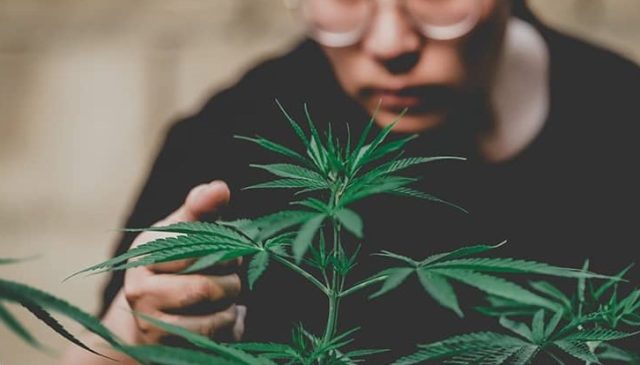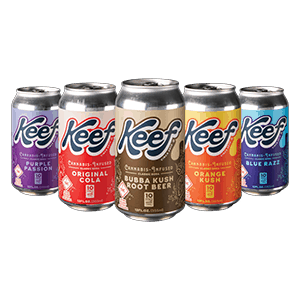
Cannabis beverages are becoming a more visible product category, particularly as dispensaries begin adding adequate cooler space for brands entering the space. For Keef Brands, which has been around for years, the evolution has been steady—moving through medical markets, allowing patients to become acquainted with the product, and then getting familiar with the burgeoning adult-use landscape in the U.S.
Keef Cola originated in Boulder, Colo., in 2010, with a keen eye to the many adaptive shifts that were coming in the cannabis market. Eventually, just based on how humans interact with one another, the market would embrace cannabinoid-infused beverages. With $2.9 million in U.S. sales in Q1, according to Headset, Keef Brands makes up a large part of what remains a small (but growing) market segment.
Travis Tharp was named CEO after serving as president and COO. Here, we spoke with Tharp about the state of the cannabis beverage segment and what we can expect next.
Eric Sandy: What’s the current scope of Keef Brands in the U.S.?

Travis Tharp: We’re currently in seven states, plus Puerto Rico, and those are Colorado, California, Arizona, Oklahoma, Missouri, Maine and Ohio. We launched our three latest markets of Ohio, Maine and Missouri in the first quarter of 2021, and we’ve been very pleased with the acceptance that those people have welcomed us to in all of these states. We’ve had really great partners in all of these, because we have to work with a manufacturer in each area. You have to set up your entire ecosystem in each state, and we’ve been very fortunate to have some wonderful partners over the years. This latest group is no exception.
ES: How does Keef Brands navigates the differences between medical and adult-use markets?
TT: It’s a really good question because I think it speaks to the evolution of our company over the years. Keef was one of the original edible brands in Colorado, all the way back in 2010, and the first product lines were medical sodas at the 100-milligram level that were targeting medical patients. That was something our founder nailed, because he started working with the folks who were the early adopters—the evangelical people who wanted to be in the industry, who wanted to be a budtender, who wanted to use it for medicinal purposes. We were able to set up a really strong relationship with both consumers and retailers over the first three or four years of medical-only in Colorado, so that when it switched to adult-use and brought out our lower 10-milligram beverages, it was very warmly received.
We had some allies and support in the industry for us bringing out an adult-use option. I’ve seen that happen in a couple of different markets that we’ve gone into. And I think that’s something that we really take to heart. It’s a very significant part of our entry strategy—to take care of the medical patients and have an option for them, providing them multiple options, whether it’s something like the mocktails that are the sugary tasty beverages or something that’s more of a health-conscious, low-sugar, low-calorie option for other medical patients. Since we’ve been able to meet the market in these early stages, we’ve been able to build a really strong partnership with all the retailers and the customers. Being from Colorado and having a lot of people over the years associate a positive experience of coming out here with the brand has really helped us develop. When the new states would come on, you see the acceptance and the brand recognition is happening faster and at a higher rate than in the first couple of markets that we launched.
ES: Dosing is a big part of this conversation. How does Keef position its 10-milligram beverages and the idea of what “10 milligrams” might mean for customers?
TT: We always tell everyone that nobody reacts the exact same. Everyone needs to understand what their correct dosing is. We always subscribe to the “start low and go slow” adage. One of the benefits of beverages and the reason that people are starting to gravitate toward them versus other form factors is that when you drink a beverage, the uptake of THC happens sublingually versus going down and having to process through your stomach and your bladder. It really provides a consistent, sessionable experience that people are used to having with alcohol or something of that nature. You just don’t want people to have a negative experience when they’re trying the product.
In all of the states where we launched, we’ve been on a very aggressive education campaign. We’re in the very early stages of the life cycle of this industry. Look at the last two years, and beverage has gained a lot of from a units and sales perspective. It’s gained a lot, but it’s still a relatively small segment of the overall market with a lot of opportunity to grow. We work together with competitors to try to get the word out. The old “a rising tide lifts all ships” adage really applies in the beverage segment right now.
ES: I was going to ask about the state of the market. Beverages are a small slice of the pie right now, but they seem to be growing quickly.
TT: There’s been a good evolution of adoption of beverage. We always thought that social consumption lounges would be when beverages would start to take off. Ironically, it was during the pandemic—with people having a lot of time on at home—that they tried new products. We saw an acceleration of that, specifically, in the beverage category. You’ve seen some new entrants that are coming with very low-dose offerings, which I think is great. We address a couple of different segments of the market. We don’t address all of them currently.
We know that there’s room in the cooler—and making sure that the cooler actually exists in the retailers is something that’s been a shared endeavor and a shared challenge. Some of the original dispensaries were set up bodega-style. But you can see an evolution in the newer markets where they’re trying to adopt a different type of retail experience that incorporates a larger refrigerator, and that’s amazing,
ES: What’s the on-site consumption situation in the home state of Colorado?
TT: It been passed at the state level, and the cities are starting to implement it. It’s on the way. It’s not where California is as of yet, or some of the other states, but it has been passed and people are gearing up for it.
ES: There’s a lot of talk about “occasion-based consumption” in the industry. Where does the marketing for beverages place this product segment?
TT: Our core brand ethos is welcoming everybody to the party, whether that’s somebody who’s never experienced cannabis before or somebody who’s an old pro. That’s been one of our major points that we always try to stick to: We want people who are experiencing beverages when they’re at a barbecue not to have to go somewhere else and remove themselves from the party. They can stay there with it, with a beverage, and stand next to their friends who are having a beer or some other beverage and still be a part of the party and not have to actually excuse themselves. That’s a really interesting shift. Something that we really try to adopt and educate people on is that it allows you to stay in the social setting. It allows you to really enjoy a different alternative experience to just alcohol.
ES: It seems like this speaks to the broader “normalization” conversation, too.
TT: It does. One of our taglines is, “Drink your cannabis.” Our founder, about 10 years ago, started telling people that the two major forms of human interaction over the development of our history had been smoking and drinking. Everyone, in 2010, was focusing on the smoking aspect. He wanted to solve the drinking segment. He thought that would be a really interesting way to go about this, and a way for it to be normalized. His 94-year-old grandmother was one of the first people who ever tried one of his original Keef Colas. She took a sip, and she said, “Is this cannabis?” She took a sip and looked at her husband and said, “You just said I couldn’t smoke it.” And then she took another sip.
It was like a company genesis story that really helped us focus in on what we were trying to accomplish. And it’s taken longer, I think, than anybody ever plans—and most things do. There have been a couple of false starts on the anointing of beverages as the next big thing. But I think what we’re seeing is a solid acceptance from the mainstream audience of at least trying it and understanding, “What are some of the benefits? What are some of the things that they need to consider?” And that’s really all we can ask for.
ES: How does tourism fit into this? Meaning, when folks visit Denver or LA, it would seem like beverages offer a more discreet, casual way to check out this new market without buying a bunch of flower for a weekend trip.
TT: We’ve gotten that feedback from numerous people who have come from in from out of state. When we’ve gone into other states, they said, “Oh, I’ve been to Colorado. I’ve had your brand in Colorado. This is great. We love that you guys are here.” It’s a great alternative to just the traditional methods of consuming cannabis. One of the things that we’ve really tried to focus on over the past few years is making sure that we’ve got the right quality controls in place so that the Keef that you have in LA tastes the same as a Keef that you have in Maine.
ES: What’s next for Keef Brands this year?
TT: Our two key focuses this year are that we wanted to accelerate the velocity and go deeper with our product lines in our existing markets—specifically in Colorado—and really work toward normalizing a purchase of a four-pack versus just a single can. By and large, it’s been very well received, and we’re able to do some volume discussions and have it be normal. It’s like a grocery store or a liquor store experience. That’s thanks to the adoption and the acceptance of the general public.
And in Q1, like I said earlier, we launched in three new markets. We were very heads-down. Our next launch will be with Canada. Our partner there is gearing up. We think we’ll be on the market if not by the end of Q2, early Q3. That’s a really big focus of ours. We’re also looking at the new states that are coming online. Generally, I would say we’re looking toward expanding some more states over the course of the next six months.
ES: As far as those partners on the ground, what are the traits you’re looking for?
TT: I’ll use Buckeye Relief in Ohio as an example. We do our homework, and we speak with other brands. We actually co-located with Wana Brands in a couple of different facilities, and they had nothing but good things to say about the Buckeye Relief team. We were able to confirm that in every one of our interactions. When you’re in cannabis, every manufacturing relationship has unique pieces to it because every state is different. But the core qualities are, transparency, a desire to continually improve the product and a commitment to consistency. Those are the key aspects of this, and Buckeye has been great in that regard.
